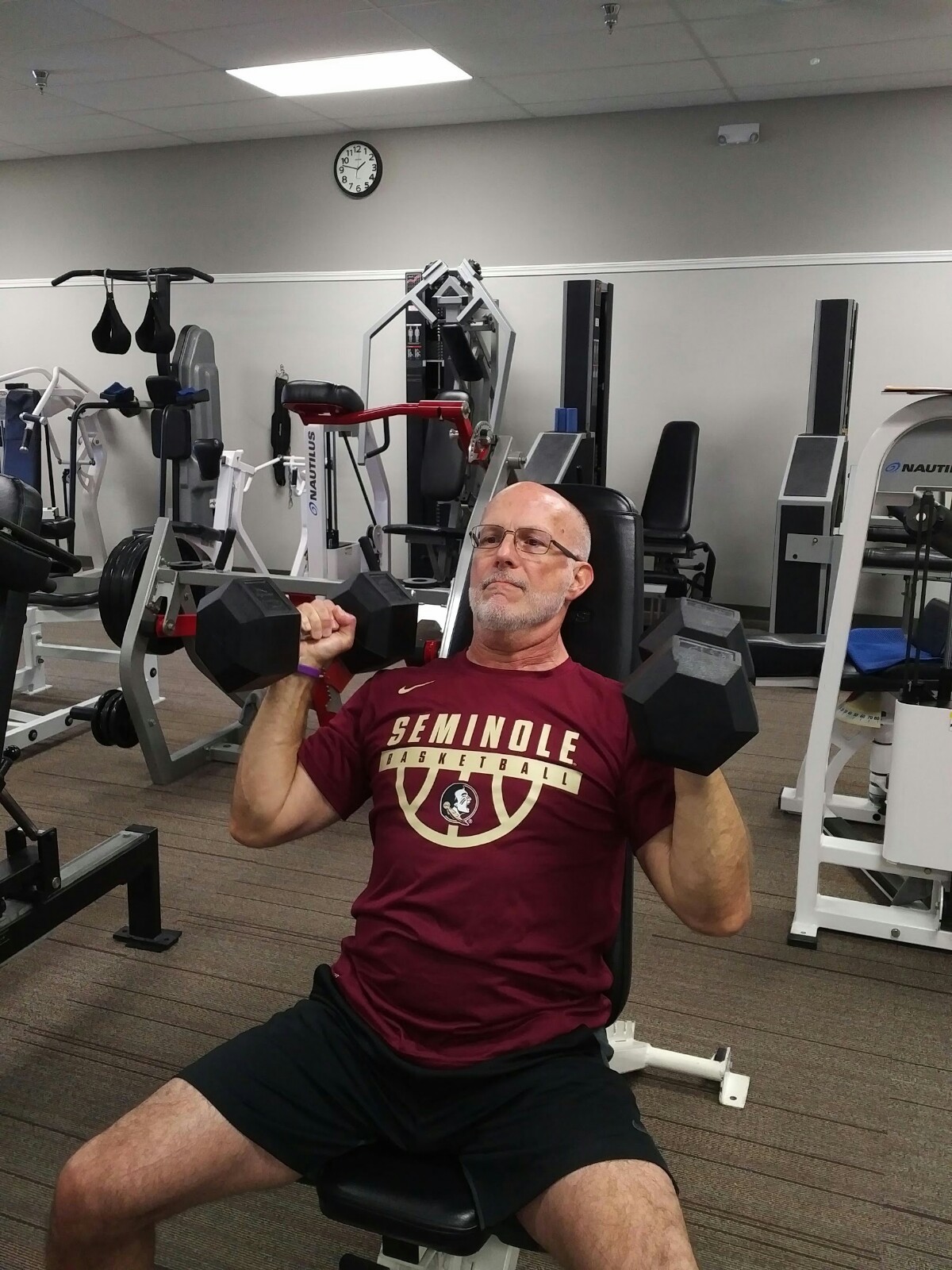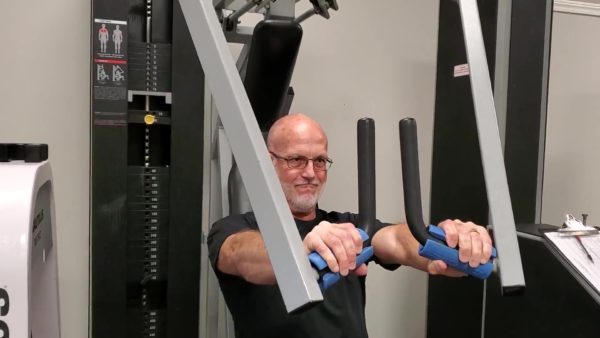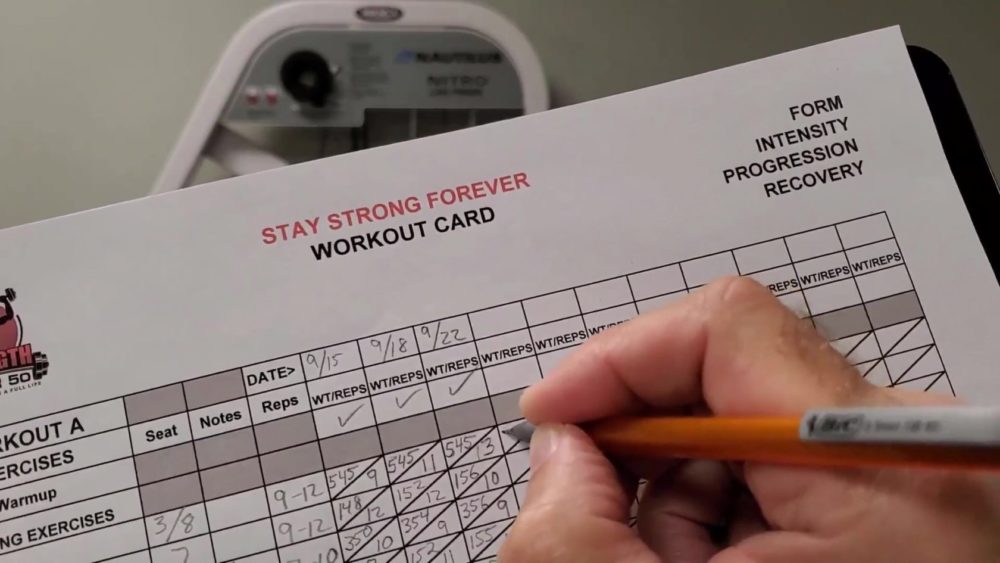Super Effective Workouts For Men Over 50 (That Won’t Take All Day To Do)
Workouts for men over 50 must meet 4 criteria to be considered super effective.
First of all, obviously your strength workouts have to be productive – that is, actually make you stronger. If your workout program isn’t producing a consistent, objectively measurable increase in muscle strength, something is drastically wrong.
Assuming that your workouts are definitely making you stronger, it is critically important that your workout program is safe. Getting hurt in the gym is both counterproductive and demoralizing. And while there is always some risk, there are a few things we can do to minimize the risk of injury.
Next on our list of criteria for super effective workouts is to make sure those workouts are sustainable. You’ll be needing a workout plan that you can easily personalize and stick with for the rest of your life.
Once our workouts are productive, safe, and sustainable, the last step in our quest for super effective workouts is to make them time-efficient. Our bodies are different now, and at this stage of our lives we don’t have the time to be “gym rats” anyway.
So now that we know what criteria need to be met for super-effective workouts for men over 50 – how do you put together a strength training program for yourself that includes workouts that satisfy all of these criteria?
That’s exactly what I’ll help you figure out in this post.
Related Content on workouts for men over 50:
-
Case Study: How I Added 2.2 Pounds Of Muscle With Four 30-Minute Workouts At Age 63
-
Subscriber Q and A Video: 5 Great Free Weight Exercises For Over 50
- 10 Home Gym Essentials On A Budget For Full Body Workouts To Get You Strong Really Fast
- The Ultimate Strength Training Program For Over 50 To Start Feeling Great Now
Workouts for Men Over 50: Effective Routines for Strength and Longevity
Understanding Age-Related Physical Changes
As you age, your body undergoes several changes that can affect your workouts. Knowing how hormonal shifts and joint health impact your physical capacity is crucial.
Hormonal Shifts and Muscle Mass
One of the key changes is related to testosterone levels. Testosterone plays a vital role in maintaining muscle mass and strength.
As men age, testosterone levels naturally decline. This reduction can contribute to a condition known as sarcopenia, where there’s a noticeable loss of muscle mass and strength.
To combat sarcopenia, incorporating resistance training into your routine is essential. Exercises like weightlifting can help slow down muscle loss and maintain muscle mass. Furthermore, ensuring adequate protein intake supports muscle repair and growth, which becomes more critical as you age.
Joint Health and Flexibility Concerns
Joint health and flexibility also often decline with age. This can be due to the wear and tear on joints or conditions like arthritis. Reduced flexibility and joint problems can make certain exercises more challenging and increase the risk of injuries.
To keep your joints healthy, consider low-impact exercises such as swimming or cycling. These activities put less strain on your joints while still providing cardiovascular benefits.
Additionally, regular stretching can improve flexibility and reduce stiffness.
Incorporating exercises specifically designed to strengthen the muscles around the joints can also offer extra support and reduce pain.
Benefits of Exercise for Men Over 50
Regular exercise brings numerous health benefits, especially for men over 50, including increased metabolic rate and improved bone density and heart health.
Boosting Metabolic Rate
As you age, your metabolic rate naturally declines, leading to weight gain and reduced energy levels. Engaging in regular exercise can help counteract this by boosting your metabolism. Activities like resistance training are particularly effective.
Strength training, such as lifting weights, helps increase and maintain muscle mass, which burns more calories at rest.
Cardiovascular exercises, such as brisk walking or cycling, also play a crucial role. They not only elevate your heart rate during activity but also have an afterburn effect, where your body continues to burn calories post-exercise. This combination makes your body more efficient at using energy, improving overall endurance and daily performance.
Improving Bone Density and Heart Health
Bone density tends to decrease with age, increasing the risk of fractures and osteoporosis. Weight-bearing exercises help stimulate bone formation and increase bone density. This is crucial for maintaining strong bones and preventing fractures.
In addition to strengthening bones, regular exercise is essential for maintaining heart health. Aerobic activities, such as swimming or running, improve cardiovascular fitness by enhancing heart function and lowering blood pressure. Studies show that consistent exercise reduces the risk of chronic conditions like heart disease.
This dual benefit makes exercise a key component of a healthy lifestyle for older guys.
Designing a Workout Plan
Creating an effective workout plan for men over 50 requires clear goals and a variety of training methods to address fitness needs and promote muscle growth while maintaining balance and reducing injury risk.
First, I want to clear up something I get asked a lot when it comes to choosing the best workouts for men over 50:
“Should I embrace high intensity interval training?”
High-intensity interval training (HIIT) refers to the short bursts of intense exercise alternated with low-intensity recovery periods. For example, a HIIT workout using a stationary exercise bike could consist of 20 seconds of cycling as fast as possible against high resistance, followed by 40 seconds of slow, easy cycling with low resistance.

So it’s a challenging workout, but that type of training is not productive with regard to increasing strength and muscle mass.
The primary benefits of HIIT are weight loss, higher metabolic rate for hours after exercise, and overall health. (Menshealth.com)
This style of training is mainly a cardiovascular workout designed to get your heart rate up – it is NOT designed to increase strength.
Weight training continues to be the “gold standard” form of exercise to increase muscle mass.

If you want to build muscle, you need to lift heavy weights, and progressively overload your muscles so they are forced to adapt by getting bigger and stronger.
And depending on the type of activities and exercises included in a HIIT workout, a lot of athleticism could be required, making the program less safe and not sustainable. So there’s 3 out of our 4 criteria out the window.

You can still take advantage of the time efficiency of HIIT while adding the best possible strength and muscle building techniques – just take out the 2nd “I”, “Interval”. That leaves High Intensity Training, and that will meet all 4 of our criteria for super effective workouts.
Here’s what to do instead:
Productive strength training to build essential muscle
It shouldn’t take years, or even months, for your strength training program to produce results; it should happen immediately, right from your first workout.
To accomplish this, you have to regularly attempt to lift more weight, or do more reps, or both. This is known as the principle of progressive overload. That means you have to put in a maximum effort on every set (excluding warm-ups) to keep the intensity of the workout high. The closer you can get to a 100% effort, the stronger you will get, and your reps and weight will go up on the majority of exercises in your workout plan right away, and keep happening for a long time.
The final rep in each set should be the last rep you can possibly complete with proper form, and is the most productive repetition of the set.
Safe, sustainable muscle building workouts for men over 50
In medical school, students are taught the ancient Greek phrase “primum non nocere”, which means “first do no harm”. You need to have this attitude when designing your own workouts.
Here are some guidelines to help you make your workouts safe:
- Make sure you can exit the exercise safely at any time.
- On any exercise where you will be under the weight, make sure there is some barrier to catch the weight to prevent you from getting stuck under it. (Don’t be the next guy in a YouTube video getting trapped under the weight while doing a bench press).
- The more complex an exercise is to perform, the more dangerous and less intense it will be. For example, power cleans or Olympic lifts.
- If you have back problems, it’s a good idea to always have your chest or back supported during an exercise. For example, seated dumbbell curls would be preferable to standing barbell curls.
- If you want your shoulders to stay healthy, don’t put anything behind your neck. This includes barbell squats and behind the neck pulldowns or shoulder presses.
If you follow the safety guidelines above, you will be setting yourself up for future success by making your workout program sustainable. Make sure the exercises you put in today are safe and simple to perform, so you can perform them not just right now when you’re 55, but also when your 65, 75 or 85.
And you’ll also need to make sure you are creating brief, infrequent workouts that easily fit into your busy schedule – in other words, a program that’s time efficient.
Introduce full body strength training for time efficiency
When you work out in the fashion described above and make the intensity of your workout high (which is necessary to get stronger), it will necessarily be brief, because intensity of effort and duration of effort are inversely proportional.
In simple terms, you can either strength train hard, or you can train for a long time, but you can’t do both. And training hard for a short period of time is necessary to build strength and lean muscle mass. It’s the exercise equivalent of using a tanning bed to get a suntan.
This is great news, because if you’re willing to commit to putting in a maximum effort, you only need to do one set per exercise, and that means you can complete a full body workout in under 45 minutes, achieving our goal of time efficiency.
So what exactly does a workout like that look like?
The ideal full body strength training workout for men over 50
Now let’s put together a sample workout that is productive, safe, sustainable and time efficient. This is the exact template I use to create individualized workouts for the clients in my Online Coaching programs.
General warm up
- Lower body push – leg press
- Lower body flexion – leg curl (knee flexion) OR calf raise (plantar flexion)
- Upper body push – chest press OR shoulder press
- Upper body pull – pulldowns OR seated row
- Midsection (‘core’) – trunk flexion (for abdominal muscles) OR trunk extension (for low back muscles)
- Rebuilding exercise #1: shoulder external rotation (for rotator cuff muscles)
- Rebuilding exercise #2: strongest range leg press (for knee pain)
- Rebuilding exercise #3: Wrist roller (for grip strengthening)
Stretching
Instructions: After warming up for 5-10 minutes on a bike, treadmill, or using light weights, perform 1 set of each exercise using a slow, controlled rep speed with a maximum effort, until no further reps are possible with good form. Shoot for 9-12 reps for lower body and 7-10 reps for upper body. If you can do more than the high number in those rep ranges on an exercise, increase the weight on your next workout to drop you back down into the rep range. When finished, stretch for 5-10 minutes, concentrating on the shoulders and hips. Once you get the hang of things, this whole process takes under 45 minutes, and you only need to do it once or twice a week.
The movements in this program cover all the major muscle groups as well the deep muscles that protect our joints.
Cardiovascular Considerations
Incorporating cardiovascular exercises is crucial for men over 50 to enhance endurance, boost stamina, and support fat loss. Focusing on the right types of cardio and understanding their benefits can greatly improve heart health and manage high blood pressure.
Low-Impact Cardio Options
Low-impact cardio exercises reduce strain on the joints while providing excellent cardiovascular benefits. Walking is a highly recommended option that strengthens the heart and improves overall stamina. Cycling on a stationary bike can also be very effective, offering a controlled environment to manage intensity levels. Swimming engages multiple muscle groups and enhances endurance without stressing the joints.
Yoga and Tai Chi are excellent for those looking to combine low-impact cardio with flexibility and balance training. These exercises can also help in lowering blood pressure. By incorporating such activities regularly, you ensure a balanced workout that promotes heart health and minimizes injury risks.
Cardio for Fat Loss
To target fat loss effectively, incorporating cardio exercises that elevate your heart rate is essential. Brisk walking and jogging are also effective for fat burning, especially when performed consistently.
Monitoring your heart rate during these activities ensures you stay in the optimal target heat rate zone. A good target heart rate is 80% of 220 – your age.
Alongside regular cardio sessions, maintaining a balanced diet is crucial to lose weight efficiently and enhance overall cardiovascular health.
Combining these approaches will not only help in reducing body fat but also improve endurance and stamina, contributing to better management of high blood pressure.
Recovery Strategies
Efficient recovery techniques can enhance workout benefits, minimize muscle damage, and support long-term fitness goals. Focus on proper nutrition and structured rest for optimal muscle repair and reduced fatigue.
Nutrition
Proper nutrition is pivotal in muscle recovery. After workouts, prioritize protein intake since it plays a key role in muscle repair and growth. Foods such as chicken, fish, and legumes are excellent protein sources. In addition, consider protein shakes or bars for a convenient protein boost.
Don’t overlook carbohydrates. They replenish glycogen stores and promote recovery. Whole grains, fruits, and vegetables are optimal choices.
Rest and Muscle Repair
Rest is a crucial element of any recovery strategy. Ensure you get at least 7-9 hours of sleep per night to aid muscle repair and overall recovery. Sleep facilitates the release of growth hormone, which is essential for muscle growth and repair.
Incorporate active rest days 2-3 days per week. Light activities such as walking or yoga can improve blood flow, aiding the recovery process without putting extra strain on muscles. Gentle stretching can alleviate muscle tension and enhance flexibility.
Prioritize listening to your body and adjusting your rest days based on how you feel post-workout.
Preventing Injuries
Preventing injuries while working out is crucial, especially for men over 50. Key strategies include utilizing proper form during exercises and understanding body limitations to avoid exacerbating chronic conditions or causing unnecessary aches and pains.
Utilizing Proper Form
Using proper form during workouts is essential for both safety and effectiveness. Incorrect form can lead to musculoskeletal injuries, especially when engaging in vigorous exercise. Focus on maintaining alignment, such as keeping your spine neutral and not over-stretching your joints.
If you’re lifting weights, ensure your movements are controlled and deliberate. Jerky or fast motions can strain muscles and joints.
Flexibility exercises like stretching should be incorporated to improve range of motion and decrease the risk of injuries. Additionally, using mirrors to check your form can prevent mistakes. Always warm up with light weights before your heavy sets, and gradually increase the load as you get stronger.
Understanding Body Limitations
Understanding your body’s limitations is equally important to prevent overexertion and injuries. Men over 50 may have to deal with chronic conditions such as arthritis which can impact the type of exercises that are safe to perform.
Listen to your body. If you feel sharp pain, it’s a sign to stop and reassess your activity.
Distinguish between normal post-exercise soreness and pain that could indicate injury.
Modify exercises to accommodate your limitations—for instance, use a reduced range of motion to manage joint pain.
Effective recovery techniques, like adequate rest, hydration, and nutrition, also play a significant role in preventing injuries.
Specialized Workouts for Specific Needs
Targeted workouts are crucial in ensuring both safety and effectiveness, especially for men over 50. This includes tailoring exercise routines to accommodate chronic conditions and other specific health concerns.
Training with Chronic Conditions
When working out with chronic conditions such as arthritis, diabetes, or heart disease, it is essential to factor in the limitations and risks associated with these health issues. Consulting with a physician before beginning any new exercise regimen is advised.
Arthritis: Low-impact exercises like swimming or cycling can reduce joint stress while maintaining cardiovascular health. Strength training with slow, controlled repetitions helps improve joint stability.
Heart Disease: Cardiovascular exercises such as brisk walking or light jogging are beneficial. Monitor heart rate during workouts to ensure it remains within a safe range.
Diabetes: Maintaining blood glucose levels is crucial. Activities like resistance training can help improve insulin sensitivity. Keep snacks or glucose tablets handy to manage low blood sugar episodes.
Working with a personal trainer (PT) experienced in client-specific needs can help develop a program that addresses body fat reduction, improves strength, and enhances overall health. Regular communication with your PT ensures that exercises are adapted as your condition or fitness level changes.
Adopting a schedule that includes flexibility, strength, and aerobic exercises is paramount in mitigating the effects of chronic conditions and improving quality of life.
Measuring Progress and Staying Motivated
Tracking fitness progress and staying motivated are crucial elements for over 50s engaging in workouts. By focusing on realistic expectations and tracking fitness milestones, you can maintain motivation and see tangible improvements in performance and mental health.
Setting Realistic Expectations
Setting realistic expectations is vital to maintain motivation and avoid frustration. Begin by understanding your current fitness level and any limitations. Consult with a fitness professional to set achievable goals based on your individual needs.
Identify short-term and long-term goals. Short-term goals might include increasing the number of reps or a small increase in the weight used. Long-term goals could involve weight loss, max muscle gain, or enhanced cardiovascular health.
It’s important to be patient with your progress. Progress may be slower compared to younger individuals, but consistent effort will lead to improvements over time.
Celebrate small victories as they occur! These wins boost confidence and reinforce the habit of regular exercise.
Tracking Fitness Milestones
Tracking your fitness milestones helps maintain motivation and provides a clear picture of progress. Utilize a journal or fitness app to record metrics such as the amount of weight used, repetitions, and overall workout performance.
Tracking weekly or monthly progress allows you to adjust your workout plan as needed. Visual representations like charts or graphs can make it easier to see progress and stay encouraged.
Maintaining detailed records aids in recognizing patterns and potential setbacks, enabling timely adjustments to your routine for continued improvement.
Frequently Asked Questions
When it comes to workouts for men over 50, understanding the best exercises, frequency, and types of workouts is crucial for maintaining health and fitness. Below are key questions and answers addressing this topic.
What is the best workout routine for men over 50?
The best workout routine for men over 50 includes a mix of cardio, strength training, and flexibility exercises. Cardio activities like brisk walking or cycling improve heart health. Strength training with weights or resistance bands helps maintain muscle mass and bone density.
How much should a 50-year-old man workout to maintain health?
A 50-year-old man should aim for at least 150 minutes of moderate-intensity or 75 minutes of vigorous-intensity aerobic activity per week. Incorporating muscle-strengthening activities on one or two days a week is also recommended to maintain overall health.
Are there specific weight training routines recommended for men over 50?
Yes, weight training routines for men over 50 should focus on full body workouts with both compound movements and single joint exercises. These exercises target multiple muscle groups, promoting strength and stability. Using slow, controlled repetitions can reduce the risk of injury while still building muscle.
Can you suggest effective weight loss exercises for a 50-year-old man?
Effective weight loss exercises for men over 50 include low-impact activities like walking, swimming, cycling or hiking 2-3 times per week, as well as strength training once or twice per week. Physical activity helps burn calories, while strength training increases muscle mass, boosting metabolism.
What are some suitable types of workouts for men over 50 that can be done at home?
Workouts suitable for men over 50 that can be done at home include bodyweight exercises such as push-ups, pull ups, squats, and lunges. Resistance band workouts are also effective and convenient. Online fitness programs or videos tailored to older adults can provide guided routines.
How many days a week should a 50-year-old man engage in physical activity?
A 50-year-old man should engage in physical activity ideally at least 3-5 days per week. This can include a mix of cardio, strength training, and flexibility exercises. Consistency is key to achieving and maintaining fitness and health goals.
Key Takeaways
- Consistency in workouts is key for men over 50 to maintain health and mobility.
- Regularly track progress and adjust your plan for continued motivation and improvement.
- Focus on strength training exercises tailored to your fitness level.
Strength training workouts for men over 50 offer many long-term health and fitness benefits. But to receive those benefits, you need to design a strength training program that not only produces the desired results, but is also safe, simple to perform, and time efficient. Doing so will make your workouts something you can sustain forever.
Strength training is the closest thing we have to a real-life Fountain of Youth. A 20+ year retirement is a terrible thing to waste, and strength training workouts that are productive, safe, sustainable and time efficient will keep you strong and healthy enough to make the most of those years.




10 Comments. Leave new
Excellent advice.
There are several health goals we all should heed as we age and maintaining muscle mass is a big one. Possessing more muscle has zero downside for us dudes (and dudettes): 1) stronger/more functional, 2) an increased metabolic rate that combats potential fat storage, and 3) possess a better physique (Speedo and bikini season is year-round in many locales on Planet Earth).
As Dave says, preserving (or even increasing) muscle is not time consuming if you train hard each session because – by necessity – one needs complete rest days between those infrequent sessions to reap the results of the intense effort exuded! It’s biology, folks.
Thanks for those insights Tom! I think another big health benefit of strength training as we age is in decreasing the aches and pains that come back to remind us of old injuries of the past; not to mention that having bigger, stronger muscles helps make us more resistant to future musculo-skeletal injuries, which of course are harder to recover from the older we are.
Our health is without a doubt our greatest asset, and a sound strength training program is a great way to protect that asset!
Do you still recommend deadlifts Dave? What exercises could you substitute for them? I find as I get older they are not as productive as they use to be. Thanks.
Hi Rodney, I think as we get older it’s best to retire the deadlift, for safety’s sake. Any slightest break in proper form could result in an injury that may set back your training, and in my book that risk is too high to justify the reward.
The alternative is to segment out the different phases of the deadlift and perform 3 different exercises to cover the same muscle groups: a lower body push, like the leg press; a shrug; and a back extension exercise. Just work those into your routine somewhere and you’re hitting the same muscles without the risk.
Thank you Dave.
You’re welcome Rodney!
EXCELLENT advice all around – I would add Clarrence Bass as a good example 👍
I couldn’t agree more Doug, I’ve been reading Clarence’s work for many years – he definitely walks the talk!
Very useful tips that make me think, as I’m already 50 years old. Even if I don’t have more serious problems, I should step back a bit and no longer do for example 10×1 attempts at 90-92% of my max of heavy exercise. But it started to hurt here and there. I no longer do several sets with the same weight, but for example 1 set to the heaviest 10 or 12 reps. The workout is similar to the one in the article, but in one workout I do horizontal push, vertical pull, triceps, biceps, front thigh and calf, and in the other vertical push, horizontal pull, biceps, triceps, rear thigh and abs. In reality, I have 1 set per exercise up to a maximum of 10-12 repetitions, which makes a total of 6 working sets per workout.
I saw the article by chance and even though 2 years have passed I decided to write.
Greetings.
Greetings Deyan, great to hear from you – it sounds like your body was sending you a message that you needed to make some changes to your routine, and you listened and made the right changes. Great job!